Review of Design Elements within Power Infrastructure Cyber–Physical Test Beds as Threat Analysis Environments
Abstract
1. Introduction
2. Hardware Components for Constructing Cyber–Physical Test Beds
2.1. Advantages and Disadvantages of Physical Hardware, Emulators And Simulators
2.2. Hardware-, Emulator-, And Simulator-Based Representaitons of Physical, Cybernetic, and Cyber–Physical Elements within CPTs
3. Soft Components for Cyber–Physical Testbeds
3.1. Common Communication Protocols for CPSs and CPTs
3.2. Timing and Data Synchronization
- Global Navigation Satellite System (GNSS) is a system of satellites with global coverage, facilitating geospatial positioning and precise time [50]. GNSS is an American company. GLONASS is a similar system owned by the Russian state corporation Roscosmos. Time references provided by these GPS systems have accuracy to less than 100 nanoseconds, sufficient for most power-system applications [50].
- The American Inter Range Instrumentation Group (IRIG) contains several standards, including IRIG Standard 200-98, IRIG-B, and IRIG Standard 200-04. This method uses a continuous stream of binary data to distribute time information. IRIG-B is the most common standard; it facilitates geographically separated locations synchronizing to a single time source [50].
- Network Time Protocol (NTP) is designed to synchronize clocks of multiple computers over a packet network. In order to synchronize clocks over the network, the network delay between clocks must be known. Therefore, the accuracy of NTP depends on network traffic. The accuracy of this method on LANs is around 1 millisecond and is on the order of tens of milliseconds for wide area networks (WANs) [50].
- IEEE 1588 is designed for systems which require highly accurate time synchronization. Rather than using packet network, this approach uses “hardware time-stamping” to distribute time. The accuracy of this method lies under a microsecond [50] and is a popular standard to synchronize clocks on distributed systems.
3.3. Wide-Area Situational Awareness
4. User interface for Cyber–Physical Testbeds
Event Visualization Dashboard
5. Cyber–Physical System Testing
6. Example of Cyber–Physical Analysis And Design
6.1. Simulation-Based Case Study
6.2. Cyber-Attack Vectors
- Scaling attack: This attack involves modifying the measurement signal to a higher or lower value, depending on the scaling attack parameter, , as shown in (1).
- Ramp attack: This attack vector involves adding a time-varying ramp signal to the input control signal based on a ramp signal parameter, , as shown in (2).
6.3. Results and Discussions
6.4. Potential Mitigation Solutions for Data-Integrity Attacks
- Signature-based IDS relies on network traffic to detect different classes of data-integrity attacks based on the defined attack-signature database. Several IDS tools, including BRO (Zeek), Snort, Firestorm, and Spade can be applied in developing signature-based IDS in real-time in a cyber–physical test bed environment.
- Anomaly-based IDS detects intrusions based on deviations from the normal behavior of the distribution system. It includes different types, such as model-based IDS, machine-learning-based IDS, multi-agent-based IDS. These are discussed below.
- (a)
- Model-based IDS utilizes the current grid information, historical measurements, and other relevant information to develop a baseline model and detects attacks based on the statistical and temporal correlation analysis of incoming grid measurements.
- (b)
- Learning-based IDS applies machine learning, deep-learning, and data mining algorithms to identify different types of stealthy and sophisticated attacks using grid measurements. Further, it also distinguishes them from other events, including line faults, extreme weather events, etc. For example, decision tree algorithms can be utilized in detecting different data integrity attacks using synchrophasor measurements in real-time.
- (c)
- Multi-agent-based IDS consists of several distributed agents that utilize both cyber and physical measurements to develop anomaly detection algorithms through agent co-ordination and information sharing. Further, it can be utilized for developing attack-resilient protection and control schemes that can detect attacks at an early stage and initiate necessary mitigation strategies to restore the normal operation of the power grid.
7. Conclusions
Author Contributions
Funding
Acknowledgments
Conflicts of Interest
Abbreviations
| ASR | Aggregated system resources |
| CITRC | Critical Infrastructure Test Range Complex |
| CPS | Cyber–physical systems |
| CPT | Cyber–physical testbeds |
| CT | Current transformer |
| DER | Distributed energy resorces |
| DNP3 | Distributed network protocol 3 |
| DoS | Denial of service |
| EMT | Electromagnetic transient |
| FBT | Fault injection-based testing |
| GNSS | Global Navigation Satellite System |
| GOOSE | Generic object-oriented substation events |
| HIL | Hardware in the loop |
| HMI | Human machine interfaces |
| HVAC | High voltage alternating current |
| HVDC | High voltage direct current |
| ICT | Information communication technologies |
| IDS | Intrusion detection systems |
| IEC | International Electrical Commission |
| IED | Intelligent electronic device |
| IEEE | Institute of Electrical and Electronics Engineers |
| INL | Idaho National Laboratory |
| IP | Internet protocol |
| IRIG | American Inter Range Instrumentation Group |
| I/O | Input/output |
| LAN | Local area network |
| MBT | Model based testing |
| NIST | National Institute of Standards |
| NTP | Network time protocol |
| OPC | Open platform communications |
| OSI | Open systems interconnection |
| OTI | Operational trust indicator |
| PLC | Programmable logic controller |
| PMU | Phasor measurement unit |
| SBT | Search-based testing |
| SCADA | Supervisory control and data acquisition |
| TCP | Transmission control protocol |
| UA | Unified architecture |
| VT | Voltage transformer |
| WAN | Wide area network |
| XML | eXtensible Markup Language |
References
- Vaagensmith, B.; McJunkin, T.; Vedros, K.; Reeves, J.; Wayment, J.; Boire, L.; Rieger, C.; Case, J. An Integrated Approach to Improving Power Grid Reliability: Merging of Probabilistic Risk Assessment with Resilience Metrics. In Proceedings of the 2018 Resilience Week (RWS), Denver, CO, USA, 20–23 August 2018; pp. 139–146. [Google Scholar]
- Whitehead, D.E.; Owens, K.; Gammel, D.; Smith, J. Ukraine cyber-induced power outage: Analysis and practical mitigation strategies. In Proceedings of the 2017 70th Annual Conference for Protective Relay Engineers (CPRE), College Station, TX, USA, 3–6 April 2017; pp. 1–8. [Google Scholar]
- Shipp, D.D.; Dionise, T.J.; Lorch, V.; MacFarlane, B.G. Transformer Failure Due to Circuit-Breaker-Induced Switching Transients. IEEE Trans. Ind. Appl. 2011, 47, 707–718. [Google Scholar] [CrossRef]
- Zeller, M. Myth or reality—Does the Aurora vulnerability pose a risk to my generator? In Proceedings of the 2011 64th Annual Conference for Protective Relay Engineers, College Station, TX, USA, 11–14 April 2011; pp. 130–136. [Google Scholar]
- Salmon, D.; Zeller, M.; Guzmán, A.; Mynam, V.; Donolo, M. Mitigating the aurora vulnerability with existing technology. In Proceedings of the 36th Annual Western Protection Relay Conference, Atlanta, GA, USA, 5–7 May 2010. [Google Scholar]
- Pollock, C. Gov. Greg Abbott Warns Texas Agencies Seeing 10,000 Attempted Cyber Attacks per Minute from Iran; The Texas Tribune: Austin, TX, USA, 2020. [Google Scholar]
- Hahn, A.; Ashok, A.; Sridhar, S.; Govindarasu, M. Cyber-physical security testbeds: Architecture, application, and evaluation for smart grid. IEEE Trans. Smart Grid 2013, 4, 847–855. [Google Scholar] [CrossRef]
- Budnik, C.J.; Eckl, S.; Gario, M. Testbed for Model-based Verification of Cyber-physical Production Systems. In ARCH@ CPSWeek; 2017; pp. 92–99. [Google Scholar]
- Liu, X.F.; Shahriar, M.R.; Al Sunny, S.N.; Leu, M.C.; Hu, L. Cyber-physical manufacturing cloud: Architecture, virtualization, communication, and testbed. J. Manuf. Syst. 2017, 43, 352–364. [Google Scholar] [CrossRef]
- Saeed, A.; Neishaboori, A.; Mohamed, A.; Harras, K.A. Up and away: A visually-controlled easy-to-deploy wireless UAV Cyber-Physical testbed. In Proceedings of the 2014 IEEE 10th International Conference on Wireless and Mobile Computing, Networking and Communications (WiMob), Larnaca, Cyprus, 8–10 October 2014; pp. 578–584. [Google Scholar]
- Fok, C.; Petz, A.; Stovall, D.; Paine, N.; Julien, C.; Vishwanath, S. Pharos: A Testbed for Mobile Cyber-Physical Systems; Tech. Rep. TR-ARiSE-2011-001; University of Texas at Austin: Austin, TX, USA, 2011. [Google Scholar]
- Bemani, A.; Bjorsell, N. Cyber-Physical Control of Indoor Multi-vehicle Testbed for Cooperative Driving. arXiv 2020, arXiv:2006.04421. [Google Scholar]
- Brinkmann, M.; Hahn, A. Testbed architecture for maritime cyber physical systems. In Proceedings of the 2017 IEEE 15th International Conference on Industrial Informatics (INDIN), Emden, Germany, 24–26 July 2017; pp. 923–928. [Google Scholar]
- Morris, T.; Srivastava, A.; Reaves, B.; Gao, W.; Pavurapu, K.; Reddi, R. A control system testbed to validate critical infrastructure protection concepts. Int. J. Crit. Infrastruct. Prot. 2011, 4, 88–103. [Google Scholar] [CrossRef]
- Reid, C.A.; West, G.S.; McBride, S.A. Enhanced INL Power Grid Test Bed Infrastructure–Phase I; Technical Report; Idaho National Lab.(INL): Idaho Falls, ID, USA, 2014. [Google Scholar]
- Kleimaier, M.; Brissette, Y.; Abbey, C.; Joós, G. Load design for a 25 kV distribution test line. In Proceedings of the 2013 IEEE Power & Energy Society General Meeting, Vancouver, BC, Canada, 21–25 July 2013; pp. 1–5. [Google Scholar]
- Kinsy, M.; Khan, O.; Celanovic, I.; Majstorovic, D.; Celanovic, N.; Devadas, S. Time-predictable computer architecture for cyber-physical systems: Digital emulation of power electronics systems. In Proceedings of the 2011 IEEE 32nd Real-Time Systems Symposium, Vienna, Austria, 29 November–2 December 2011; pp. 305–316. [Google Scholar]
- Kumar, P.S.; Emfinger, W.; Karsai, G. A testbed to simulate and analyze resilient cyber-physical systems. In Proceedings of the 2015 International Symposium on Rapid System Prototyping (RSP), Amsterdam, The Netherlands, 8–9 October 2015; pp. 97–103. [Google Scholar]
- Monti, A.; Stevic, M.; Vogel, S.; De Doncker, R.W.; Bompard, E.; Estbesari, A.; Profumo, F.; Hovsapian, R.; Mohanpurkar, M.; David, J. Enabling high penetration of power electronics in the electric grid through a Global Real-Time Super Lab. IEEE Power Electron. Mag. 2018, 5, 35–44. [Google Scholar] [CrossRef]
- Singh, V.K.; Govindarasu, M.; Porschet, D.; Shaffer, E.; Berman, M. Distributed Power System Simulation using Cyber-Physical Testbed Federation: Architecture, Modeling, and Evaluation. In Proceedings of the 2019 Resilience Week (RWS), San Antonio, TX, USA, 4–7 November 2019; Volume 1, pp. 26–32. [Google Scholar]
- Kao, H.A.; Jin, W.; Siegel, D.; Lee, J. A cyber physical interface for automation systems—Methodology and examples. Machines 2015, 3, 93–106. [Google Scholar] [CrossRef]
- Frömel, B. Interface design in cyber-physical systems-of-systems. In Proceedings of the 2016 11th System of Systems Engineering Conference (SoSE), Kongsberg, Norway, 12–16 June 2016; pp. 1–8. [Google Scholar]
- Hernandez, M.E.; Ramos, G.A.; Lwin, M.; Siratarnsophon, P.; Santoso, S. Embedded real-time simulation platform for power distribution systems. IEEE Access 2017, 6, 6243–6256. [Google Scholar] [CrossRef]
- Gavriluta, C.; Boudinet, C.; Kupzog, F.; Gomez-Exposito, A.; Caire, R. Cyber-physical framework for emulating distributed control systems in smart grids. Int. J. Electr. Power Energy Syst. 2020, 114, 105375. [Google Scholar] [CrossRef]
- Si, G.; Cordier, J.; Kennel, R.M. Extending the power capability with dynamic performance of a power-hardware-in-the-loop application—Power grid emulator using “inverter cumulation”. IEEE Trans. Ind. Appl. 2016, 52, 3193–3202. [Google Scholar] [CrossRef]
- Yang, L.; Ma, Y.; Wang, J.; Wang, J.; Zhang, X.; Tolbert, L.M.; Wang, F.; Tomsovic, K. Development of converter based reconfigurable power grid emulator. In Proceedings of the 2014 IEEE Energy Conversion Congress and Exposition (ECCE), Pittsburgh, PA, USA, 14–18 September 2014; pp. 3990–3997. [Google Scholar]
- Chen, C.P. Evaluating the Impact of Packet Delay and Loss on a Network Control System in DETERlab 2010.
- Mets, K.; Ojea, J.A.; Develder, C. Combining power and communication network simulation for cost-effective smart grid analysis. IEEE Commun. Surv. Tutorials 2014, 16, 1771–1796. [Google Scholar] [CrossRef]
- Agarwal, A.; Balance, J.; Bhargava, B.; Dyer, J.; Martin, K.; Mo, J. Real Time Dynamics Monitoring System (RTDMS®) for use with SynchroPhasor technology in power systems. In Proceedings of the 2011 IEEE Power and Energy Society General Meeting, Detroit, MI, USA, 24–29 July 2011; pp. 1–8. [Google Scholar]
- Mallouhi, M.; Al-Nashif, Y.; Cox, D.; Chadaga, T.; Hariri, S. A testbed for analyzing security of SCADA control systems (TASSCS). In Proceedings of the ISGT 2011, Kollam, India, 1–3 December 2011; pp. 1–7. [Google Scholar]
- Oyewumi, I.A.; Jillepalli, A.A.; Richardson, P.; Ashrafuzzaman, M.; Johnson, B.K.; Chakhchoukh, Y.; Haney, M.A.; Sheldon, F.T.; de Leon, D.C. Isaac: The idaho cps smart grid cybersecurity testbed. In Proceedings of the 2019 IEEE Texas Power and Energy Conference (TPEC), College Station, TX, USA, 7–8 February 2019; pp. 1–6. [Google Scholar]
- East, S.; Butts, J.; Papa, M.; Shenoi, S. A Taxonomy of Attacks on the DNP3 Protocol; Springer: Berlin/Heidelberg, Germany, 2009; Volume 311. [Google Scholar] [CrossRef]
- Fovino, I.N.; Carcano, A.; Masera, M.; Trombetta, A. Design and Implementation of a Secure Modbus Protocol. In Critical Infrastructure Protection III; Palmer, C., Shenoi, S., Eds.; Springer: Berlin/Heidelberg, Germany, 2009; pp. 83–96. [Google Scholar]
- Parian, C.; Guldimann, T.; Bhatia, S. Fooling the Master: Exploiting Weaknesses in the Modbus Protocol. Procedia Comput. Sci. 2020, 171, 2453–2458. [Google Scholar] [CrossRef]
- González, I.; Calderón, A.J.; Figueiredo, J.; Sousa, J. A Literature Survey on Open Platform Communications (OPC) Applied to Advanced Industrial Environments. Electronics 2019, 8, 510. [Google Scholar] [CrossRef]
- Pidikiti, D.; Kalluri, R.; Kumar, R.; Bindhumadhava, B. SCADA communication protocols: Vulnerabilities, attacks and possible mitigations. CSI Trans. ICT 2013, 1. [Google Scholar] [CrossRef]
- Elgargouri, A.; Elmusrati, M. Analysis of Cyber-Attacks on IEC 61850 Networks. In Proceedings of the 2017 IEEE 11th International Conference on Application of Information and Communication Technologies (AICT), Moscow, Russia, 20–22 September 2017; pp. 1–4. [Google Scholar] [CrossRef]
- Khan, R.; Mclaughlin, K.; Laverty, D.; Sezer, S. IEEE C37.118-2 Synchrophasor Communication Framework: Overview, Cyber Vulnerabilities Analysis and Performance Evaluation. In Proceedings of the 2nd International Conference on Information Systems Security and Privacy, Rome, Italy, 19–21 February 2016. [Google Scholar] [CrossRef][Green Version]
- Mohagheghi, S.; Stoupis, J.; Wang, Z. Communication protocols and networks for power systems-current status and future trends. In Proceedings of the 2009 IEEE/PES Power Systems Conference and Exposition, Seattle, WA, USA, 15–18 March 2009; pp. 1–9. [Google Scholar]
- Volkova, A.; Niedermeier, M.; Basmadjian, R.; de Meer, H. Security challenges in control network protocols: A survey. IEEE Commun. Surv. Tutorials 2018, 21, 619–639. [Google Scholar] [CrossRef]
- Jafary, P.; Repo, S.; Salmenpera, M.; Koivisto, H. OPC UA security for protecting substation and control center data communication in the distribution domain of the smart grid. In Proceedings of the 2015 IEEE 13th International Conference on Industrial Informatics (INDIN), Cambridge, UK, 22–24 July 2015; pp. 645–651. [Google Scholar]
- Mazur, D.C.; Sottile, J.; Novak, T. An electrical mine monitoring system utilizing the IEC 61850 standard. In Proceedings of the 2013 IEEE Industry Applications Society Annual Meeting, Lake Buena Vista, FL, USA, 6–11 October 2013; pp. 1–10. [Google Scholar]
- Borscia, R. IEC61850 companion specification for electrical substation automation systems.
- Milschiltz, B. IEC 61850 What Are You Waiting For?
- IEEE Standard for Synchrophasor Data Transfer for Power Systems. IEEE Std C37.118.2-2011 (Revision of IEEE Std C37.118-2005); 2011; pp. 1–53. [Google Scholar] [CrossRef]
- Amarasinghe, K.; Wickramasinghe, C.; Marino, D.; Rieger, C.; Manicl, M. Framework for Data Driven Health Monitoring of Cyber-Physical Systems. In Proceedings of the 2018 Resilience Week (RWS), Denver, CO, USA, 20–23 August 2018; pp. 25–30. [Google Scholar] [CrossRef]
- Rinaldi, S.; Della Giustina, D.; Ferrari, P.; Flammini, A.; Sisinni, E. Time synchronization over heterogeneous network for smart grid application: Design and characterization of a real case. Ad Hoc Netw. 2016, 50, 41–57. [Google Scholar] [CrossRef]
- Allnutt, J.; Anand, D.; Arnold, D.; Goldstein, A.; Li-Baboud, Y.; Martin, A.; Nguyen, C.T.; Noseworthy, R.; Subramaniam, R.; Weiss, M. Timing Challenges in the Smart Grid; NIST: Gaithersburg, MD, USA, 2017. [Google Scholar]
- Chalangar, H.; Ould-Bachir, T.; Sheshyekani, K.; Li, S.; Mahseredjian, J. Evaluation of a Constant Parameter Line-Based TWFL Real-Time Testbed. IEEE Trans. Power Deliv. 2019, 35, 1010–1019. [Google Scholar] [CrossRef]
- Aweya, J.; Al Sindi, N. Role of Time Synchronization in Power System Automation and Smart Grids. In Proceedings of the 2013 IEEE International Conference on Industrial Technology (ICIT), Cape Town, South Africa, 25–28 February 2013; pp. 1392–1397. [Google Scholar] [CrossRef]
- Adhikari, U.; Morris, T.; Pan, S. WAMS cyber-physical test bed for power system, cybersecurity study, and data mining. IEEE Trans. Smart Grid 2016, 8, 2744–2753. [Google Scholar] [CrossRef]
- Pradhan, P.; Nagananda, K.; Venkitasubramaniam, P.; Kishore, S.; Blum, R.S. GPS spoofing attack characterization and detection in smart grids. In Proceedings of the 2016 IEEE Conference on Communications and Network Security (CNS), Philadelphia, PA, USA, 7–19 October 2016; pp. 391–395. [Google Scholar]
- Nighswander, T.; Ledvina, B.; Diamond, J.; Brumley, R.; Brumley, D. GPS software attacks. In Proceedings of the 2012 ACM conference on Computer and Communications Security, Raleigh, NC, USA, 16–18 October 2012; pp. 450–461. [Google Scholar]
- Hadley, M.; McBride, J.; Edgar, T.; O’Neil, L.; Johnson, J. Securing Wide Area Measurement Systems; US Department of Energy: Washington, DC, USA, 2007.
- Rabadi, D.; Tan, R.; Yau, D.K.; Viswanathan, S.; Zheng, H.; Cheng, P. Resilient Clock Synchronization using Power Grid Voltage. ACM Trans. Cyber-Phys. Syst. 2019, 3, 1–26. [Google Scholar] [CrossRef]
- Han, M.; Crossley, P. Vulnerability of IEEE 1588 under time synchronization attacks. In Proceedings of the 2019 IEEE Power & Energy Society General Meeting (PESGM), Atlanta, GA, USA, 4–8 August 2019; pp. 1–5. [Google Scholar]
- Albunashee, H.; Mc Cann, R.A. DER Coordination Strategy for Volt/VAR Control using IEC61850 GOOSE Protocol. In Proceedings of the 2019 North American Power Symposium (NAPS), Wichita, KS, USA, 13–15 October 2019; pp. 1–5. [Google Scholar]
- Youssef, T.A.; Esfahani, M.M.; Mohammed, O. Data-Centric Communication Framework for Multicast IEC 61850 Routable GOOSE Messages over the WAN in Modern Power Systems. Appl. Sci. 2020, 10, 848. [Google Scholar] [CrossRef]
- Pham, B.; Huff, C.; Vendittis, P.N.; Smit, A.; Stinskiy, A.; Chanda, S. Implementing distributed intelligence by utilizing DNP3 protocol for distribution automation application. In Proceedings of the 2018 IEEE/PES Transmission and Distribution Conference and Exposition (T&D), Denver, CO, USA, 16–19 April 2018; pp. 1–7. [Google Scholar]
- Hänsch, K.; Naumann, A.; Wenge, C.; Wolf, M. Communication for battery energy storage systems compliant with IEC 61850. Int. J. Electr. Power Energy Syst. 2018, 103, 577–586. [Google Scholar] [CrossRef]
- Villalta, V.d.O.; Netto, R.S.; Caetano, R.E.; Bonatto, B.D. Benchmarking of Performance Requirements between IEC 61850 and DNP3 in Real-Time Monitoring Context. In Proceedings of the 2018 IEEE International Conference on Environment and Electrical Engineering and 2018 IEEE Industrial and Commercial Power Systems Europe (EEEIC/I&CPS Europe), Palermo, Italy, 12–15 June 2018; pp. 1–4. [Google Scholar]
- Horalek, J.; Matyska, J.; Sobeslav, V. Communication protocols in substation automation and IEC 61850 based proposal. In Proceedings of the 2013 IEEE 14th International Symposium on Computational Intelligence and Informatics (CINTI), Budapest, Hungary, 19–21 November 2013; pp. 321–326. [Google Scholar]
- Kenner, S.; Thaler, R.; Kucera, M.; Volbert, K.; Waas, T. Comparison of smart grid architectures for monitoring and analyzing power grid data via Modbus and REST. EURASIP J. Embed. Syst. 2017, 2017, 12. [Google Scholar] [CrossRef]
- Orega, A. Performance Evaluation of the DNP3 Protocol for Smart Grid Applications over IEEE 802.3/802.11 Networks and Heterogeneous Traffic. Proc 2015.
- El Mrabet, Z.; Kaabouch, N.; El Ghazi, H.; El Ghazi, H. Cyber-security in smart grid: Survey and challenges. Comput. Electr. Eng. 2018, 67, 469–482. [Google Scholar] [CrossRef]
- National Fluid Power Association. NFPA 704 Standard System for the Identification of the Hazards of Materials for Emergency Response; Technical report; National Fluid Power Association: Quincy, MA, USA, 2017. [Google Scholar]
- Matuszak, W.; DiPippo, L.; Lindsay Sun, Y. CyberSAVe - Situational Awareness Visualization for Cyber Security of Smart Grid Systems.
- McJunkin, T.R.; Rieger, C.G. Electricity distribution system resilient control system metrics. In Proceedings of the 2017 Resilience Week (RWS), Wilmington, DE, USA, 18–22 September 2017; pp. 103–112. [Google Scholar]
- Phillips, T.; Mehrpouyan, H.; Gardner, J.; Reese, S. An Operational Resilience Metric for Modern Power Distribution Systmes. In Proceedings of the 2020 IEEE 20th International Conference on Software Quality, Reliability and Security Companion (QRS-C), Macau, China, 11–14 December 2020. [Google Scholar]
- Phillips, T.; McJunkin, T.; Rieger, C.; Gardner, J.; Mehrpouyan, H. A Framework for Evaluating the Resilience Contribution of Solar PV and Battery Storage on the Grid. In Proceedings of the 2020 Resilience Week (RWS), Salt Lake City, UT, USA, 19–23 October 2020; pp. 133–139. [Google Scholar] [CrossRef]
- Phillips, T.; Chalishazar, V.; McJunkin, T.; Maharjan, M.; Shafiul Alam, S.M.; Mosier, T.; Somani, A. A Metric Framework for Evaluating the Resilience Contribution of Hydropower to the Grid. In Proceedings of the 2020 Resilience Week (RWS), Salt Lake City, UT, USA, 19–23 October 2020; pp. 78–85. [Google Scholar] [CrossRef]
- Zhou, X.; Gou, X.; Huang, T.; Yang, S. Review on Testing of Cyber Physical Systems: Methods and Testbeds. IEEE Access 2018, 6, 52179–52194. [Google Scholar] [CrossRef]
- Silva, L.C.; Perkusich, M.; Bublitz, F.M.; Almeida, H.O.; Perkusich, A. A model-based architecture for testing medical cyber-physical systems. In Proceedings of the 29th Annual ACM Symposium on Applied Computing; Association for Computing Machinery, 2014. SAC ’14. pp. 25–30. [Google Scholar] [CrossRef]
- Jiang, Z.; Pajic, M.; Mangharam, R. Cyber–Physical Modeling of Implantable Cardiac Medical Devices. Proc. IEEE 2012, 100, 122–137. [Google Scholar] [CrossRef]
- Zander, J. Model-based testing for execution algorithms in the simulation of cyber-physical systems. In Proceedings of the 2013 IEEE AUTOTESTCON, Schaumburg, IL, USA, 16–19 September 2013; pp. 1–7, ISSN 1558-4550. [Google Scholar] [CrossRef]
- Saglietti, F.; Föhrweiser, D.; Winzinger, S.; Lill, R. Model-Based Design and Testing of Decisional Autonomy and Cooperation in Cyber-Physical Systems. In Proceedings of the 2015 41st Euromicro Conference on Software Engineering and Advanced Applications, Madeira, Portugal, 26–28 August 2015; pp. 479–483, ISSN 2376-9505. [Google Scholar] [CrossRef]
- Buzhinsky, I.; Pang, C.; Vyatkin, V. Formal Modeling of Testing Software for Cyber-Physical Automation Systems. In Proceedings of the 2015 IEEE Trustcom/BigDataSE/ISPA, Helsinki, Finland, 20–22 August 2015; Volume 3, pp. 301–306. [Google Scholar] [CrossRef]
- Kosek, A.M.; Gehrke, O. Ensemble regression model-based anomaly detection for cyber-physical intrusion detection in smart grids. In Proceedings of the 2016 IEEE Electrical Power and Energy Conference (EPEC), Ottawa, ON, Canada, 12–14 October 2016; pp. 1–7. [Google Scholar] [CrossRef]
- Aerts, A.; Mousavi, M.R.; Reniers, M. A Tool Prototype for Model-Based Testing of Cyber-Physical Systems. In Theoretical Aspects of Computing - ICTAC 2015; Leucker, M., Rueda, C., Valencia, F.D., Eds.; Springer International Publishing: Berlin/Heidelberg, Germany, 2015; Lecture Notes in Computer Science; pp. 563–572. [Google Scholar] [CrossRef]
- Ali, S.; Yue, T. U-Test: Evolving, Modelling and Testing Realistic Uncertain Behaviours of Cyber-Physical Systems. In Proceedings of the 2015 IEEE 8th International Conference on Software Testing, Verification and Validation (ICST), Graz, Austria, 13–17 April 2015; pp. 1–2, ISSN 2159-4848. [Google Scholar] [CrossRef]
- Schmidt, A.; Durak, U.; Pawletta, T. Model-based testing methodology using system entity structures for MATLAB/Simulink models. Simulation 2016, 92, 729–746. [Google Scholar] [CrossRef]
- Motii, A.; Lanusse, A.; Hamid, B.; Bruel, J.M. Model-Based Real-Time Evaluation of Security Patterns: A SCADA System Case Study. In Computer Safety, Reliability, and Security; Lecture Notes in Computer Science; Skavhaug, A., Guiochet, J., Schoitsch, E., Bitsch, F., Eds.; Springer International Publishing: Berlin/Heidelberg, Germany, 2016; pp. 375–389. [Google Scholar] [CrossRef]
- Arrieta, A.; Wang, S.; Sagardui, G.; Etxeberria, L. Search-based test case selection of cyber-physical system product lines for simulation-based validation. In Proceedings of the 20th International Systems and Software Product Line Conference. Association for Computing Machinery, Beijing, China, 16–23 September 2016; SPLC ’16. pp. 297–306. [Google Scholar] [CrossRef]
- Arrieta, A.; Wang, S.; Sagardui, G.; Etxeberria, L. Test Case Prioritization of Configurable Cyber-Physical Systems with Weight-Based Search Algorithms. In Proceedings of the Genetic and Evolutionary Computation Conference 2016. Association for Computing Machinery, Denver, CO, USA, 20–24 July 2016; GECCO ’16. pp. 1053–1060. [Google Scholar] [CrossRef]
- Matinnejad, R.; Nejati, S.; Briand, L.; Bruckmann, T.; Poull, C. Search-based automated testing of continuous controllers: Framework, tool support, and case studies. Inf. Softw. Technol. 2015, 57, 705–722. [Google Scholar] [CrossRef]
- Nie, K.; Yue, T.; Ali, S. Towards a Search-based Interactive Configuration of Cyber Physical System Product Lines. Proc. CEUR 2013, 71–75. [Google Scholar]
- Bartocci, E.; Deshmukh, J.; Donzé, A.; Fainekos, G.; Maler, O.; Ničković, D.; Sankaranarayanan, S. Specification-based monitoring of cyber-physical systems: A survey on theory, tools and applications. In Lectures on Runtime Verification; Springer: Berlin/Heidelberg, Germany, 2018; pp. 135–175. [Google Scholar]
- Lee, J.; Ardakani, H.D.; Yang, S.; Bagheri, B. Industrial Big Data Analytics and Cyber-physical Systems for Future Maintenance & Service Innovation. Procedia CIRP 2015, 38, 3–7. [Google Scholar] [CrossRef]
- Zhang, L. Designing big data driven cyber physical systems based on AADL. In Proceedings of the 2014 IEEE International Conference on Systems, Man, and Cybernetics (SMC), San Diego, CA, USA, 5–8 October 2014; pp. 3072–3077, ISSN 1062-922X. [Google Scholar] [CrossRef]
- Min, D. Medical cyber physical systems and bigdata platforms 2013.
- Department of Engineering Technology, Mississippi Valley State University, USA; Lidong, W.; Guanghui, W. Big Data in Cyber-Physical Systems, Digital Manufacturing and Industry 4.0. Int. J. Eng. Manuf. 2016, 6, 1–8. [Google Scholar] [CrossRef]
- Lee, C.K.M.; Yeung, C.L.; Cheng, M.N. Research on IoT based Cyber Physical System for Industrial big data Analytics. In Proceedings of the 2015 IEEE International Conference on Industrial Engineering and Engineering Management (IEEM), Singapore, 6–9 December 2015; pp. 1855–1859. [Google Scholar] [CrossRef]
- Lee, J.; Bagheri, B.; Kao, H.A. Recent advances and trends of cyber-physical systems and big data analytics in industrial informatics. In Proceedings of the International proceeding of int conference on industrial informatics (INDIN), Porto Alegre, Brazil, 27–30 July 2014; pp. 1–6. [Google Scholar]
- Niggemann, O.; Biswas, G.; Kinnebrew, J.; Khorasgani, H.; Volgmann, S.; Bunte, A. Data-Driven Monitoring of Cyber-Physical Systems Leveraging on Big Data and the Internet-of- Things for Diagnosis and Control. In Proceedings of the 26th International Workshop on Principles of Diagnosis, Paris, France, 31 August–3 September 2015; pp. 185–192. [Google Scholar]
- Jara, A.J.; Genoud, D.; Bocchi, Y. Big Data for Cyber Physical Systems: An Analysis of Challenges, Solutions and Opportunities. In Proceedings of the 2014 Eighth International Conference on Innovative Mobile and Internet Services in Ubiquitous Computing, Birmingham, UK, 2–4 July 2014; pp. 376–380. [Google Scholar] [CrossRef]
- Zhong, W.; Zhang, L. Challenges of Big Data based Cyber-Physical System. In Proceedings of the 2016 2nd Workshop on Advanced Research and Technology in Industry Applications; Atlantis Press, 2016. [Google Scholar] [CrossRef]
- Zhang, Y.; Qiu, M.; Tsai, C.; Hassan, M.M.; Alamri, A. Health-CPS: Healthcare Cyber-Physical System Assisted by Cloud and Big Data. IEEE Syst. J. 2017, 11, 88–95. [Google Scholar] [CrossRef]
- Abid, H.; Phuong, L.T.T.; Wang, J.; Lee, S.; Qaisar, S. V-Cloud: Vehicular cyber-physical systems and cloud computing. In Proceedings of the 4th International Symposium on Applied Sciences in Biomedical and Communication Technologies; Association for Computing Machinery, 2011. ISABEL ’11. pp. 1–5. [Google Scholar] [CrossRef]
- Hahanov, V.; Gharibi, W.; Abramova, L.S.; Chumachenko, S.; Litvinova, E.; Hahanova, A.; Rustinov, V.; Miz, V.; Zhalilo, A.; Ziarmand, A. Cyber physical system - smart cloud traffic control. In Proceedings of the IEEE East-West Design Test Symposium (EWDTS 2014); 2014; pp. 1–18. [Google Scholar] [CrossRef]
- Puttonen, J.; Afolaranmi, S.O.; Gonzalez Moctezuma, L.; Lobov, A.; Martinez Lastra, J.L. Enhancing Security in Cloud-based Cyber-physical Systems. J. Cloud Comput. Res. 2016, 2, 18–33. [Google Scholar] [CrossRef]
- Reddy, Y.B. Cloud-Based Cyber Physical Systems: Design Challenges and Security Needs. In Proceedings of the 10th International Conference on Mobile Ad-hoc and Sensor Networks, Maui, HI, USA, 19–21 December 2014; pp. 315–322. [Google Scholar] [CrossRef]
- Azab, M.; Eltoweissy, M. Defense as a service cloud for Cyber-Physical Systems. In Proceedings of the 7th International Conference on Collaborative Computing: Networking, Applications and Worksharing (CollaborateCom), Bloomington, IN, USA, 27 June–1 July 2011; pp. 392–401. [Google Scholar] [CrossRef][Green Version]
- Karnouskos, S.; Colombo, A.W.; Bangemann, T. Trends and Challenges for Cloud-Based Industrial Cyber-Physical Systems. In Industrial Cloud-Based Cyber-Physical Systems: The IMC-AESOP Approach; Colombo, A.W., Bangemann, T., Karnouskos, S., Delsing, J., Stluka, P., Harrison, R., Jammes, F., Lastra, J.L., Eds.; Springer International Publishing: Berlin/Heidelberg, Germany, 2014; pp. 231–240. [Google Scholar] [CrossRef]
- Karnouskos, S.; Colombo, A.W.; Bangemann, T.; Manninen, K.; Camp, R.; Tilly, M.; Sikora, M.; Jammes, F.; Delsing, J.; Eliasson, J.; et al. The IMC-AESOP Architecture for Cloud-Based Industrial Cyber-Physical Systems. In Industrial Cloud-Based Cyber-Physical Systems: The IMC-AESOP Approach; Colombo, A.W., Bangemann, T., Karnouskos, S., Delsing, J., Stluka, P., Harrison, R., Jammes, F., Lastra, J.L., Eds.; Springer International Publishing: Berlin/Heidelberg, Germany, 2014; pp. 49–88. [Google Scholar] [CrossRef]
- Nakauchi, K.; Bronzino, F.; Shoji, Y.; Seskar, I.; Raychaudhuri, D. vMCN: Virtual mobile cloud network for realizing scalable, real-time cyber physical systems. In Proceedings of the 4th Workshop on Distributed Cloud Computing; Association for Computing Machinery, 2016. DCC ’16. pp. 1–6. [Google Scholar] [CrossRef]
- Alam, K.M.; Saddik, A.E. C2PS: A Digital Twin Architecture Reference Model for the Cloud-Based Cyber-Physical Systems. IEEE Access 2017, 5, 2050–2062. [Google Scholar] [CrossRef]
- Shu, Z.; Wan, J.; Zhang, D.; Li, D. Cloud-Integrated Cyber-Physical Systems for Complex Industrial Applications. Mob. Netw. Appl. 2016, 21, 865–878. [Google Scholar] [CrossRef]
- Wickramasinghe, C.S.; Marino, D.L.; Amarasinghe, K.; Manic, M. Generalization of Deep Learning for Cyber-Physical System Security: A Survey. In Proceedings of the IECON 2018 - 44th Annual Conference of the IEEE Industrial Electronics Society, Washington, DC, USA, 21–23 October 2018; pp. 745–751. [Google Scholar] [CrossRef]
- Marino, D.L.; Wickramasinghe, C.S.; Amarasinghe, K.; Challa, H.; Richardson, P.; Jillepalli, A.A.; Johnson, B.K.; Rieger, C.; Manic, M. Cyber and physical anomaly detection in smart-grids. In Proceedings of the 2019 Resilience Week (RWS), San Antonio, TX, USA, 4–7 November 2019; Volume 1, pp. 187–193. [Google Scholar]
- Marino, D.L.; Wickramasinghe, C.S.; Rieger, C.; Manic, M. Data-driven stochastic anomaly detection on smart-grid communications using mixture poisson distributions. In Proceedings of the IECON 2019-45th Annual Conference of the IEEE Industrial Electronics Society, Lisbon, Portugal, 14–17 October 2019; Volume 1, pp. 5855–5861. [Google Scholar]
- Liu, S.; Liu, X.P.; El Saddik, A. Denial-of-service (DoS) attacks on load frequency control in smart grids. In Proceedings of the 2013 IEEE PES Innovative Smart Grid Technologies Conference (ISGT), Lyngby, Denmark, 6–9 October 2013; pp. 1–6. [Google Scholar]
- Li, H.; Lu, R.; Zhou, L.; Yang, B.; Shen, X. An Efficient Merkle-Tree-Based Authentication Scheme for Smart Grid. IEEE Syst. J. 2014, 8, 655–663. [Google Scholar] [CrossRef]
- Hosseinzadeh, M.; Sinopoli, B.; Garone, E. Feasibility and detection of replay attack in networked constrained cyber-physical systems. In Proceedings of the 2019 57th Annual Allerton Conference on Communication, Control, and Computing (Allerton), Monticello, IL, USA, 24–27 September 2019; pp. 712–717. [Google Scholar]
- Liu, Y.; Ning, P.; Reiter, M.K. False data injection attacks against state estimation in electric power grids. ACM Trans. Inf. Syst. Secur. (TISSEC) 2011, 14, 1–33. [Google Scholar] [CrossRef]
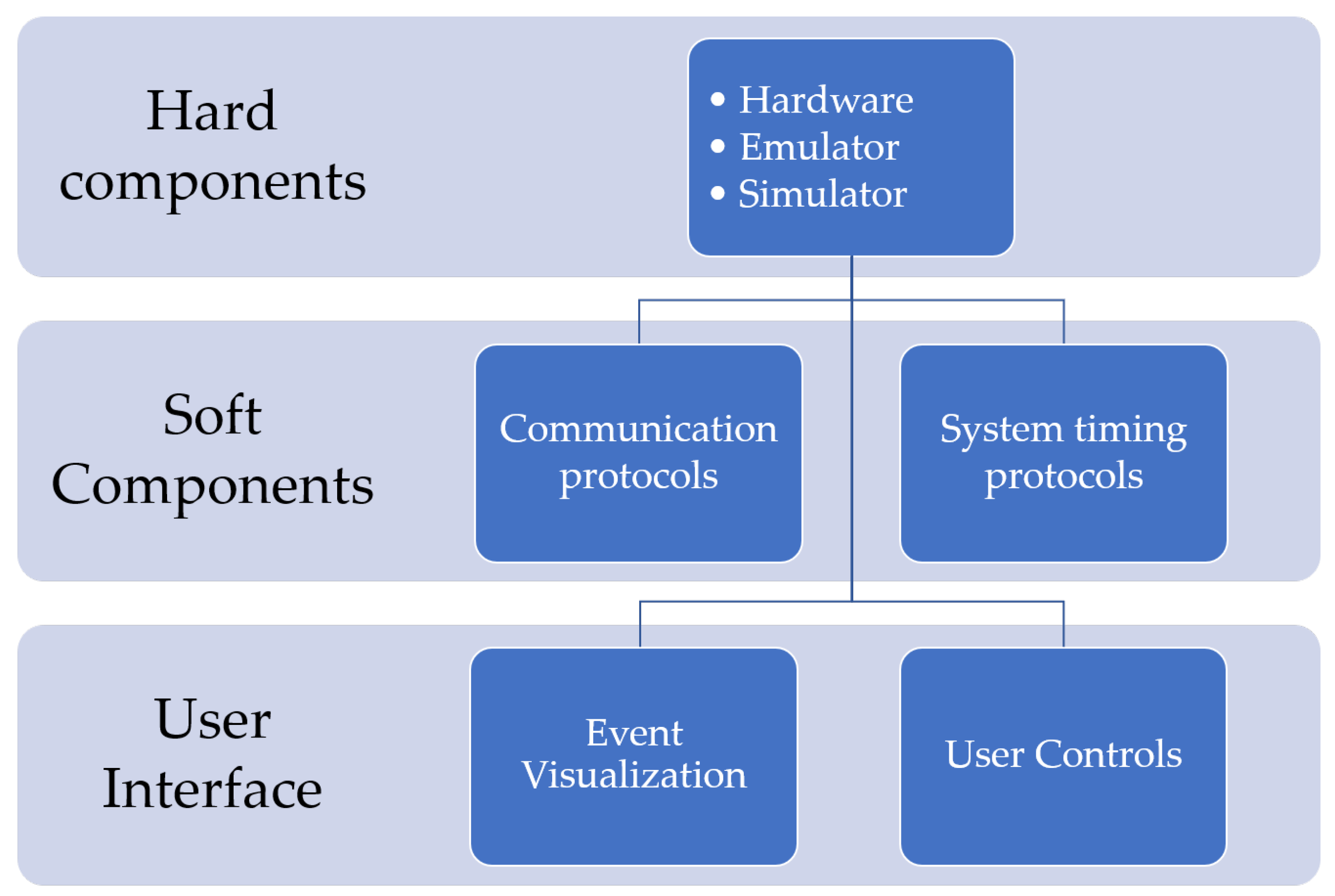
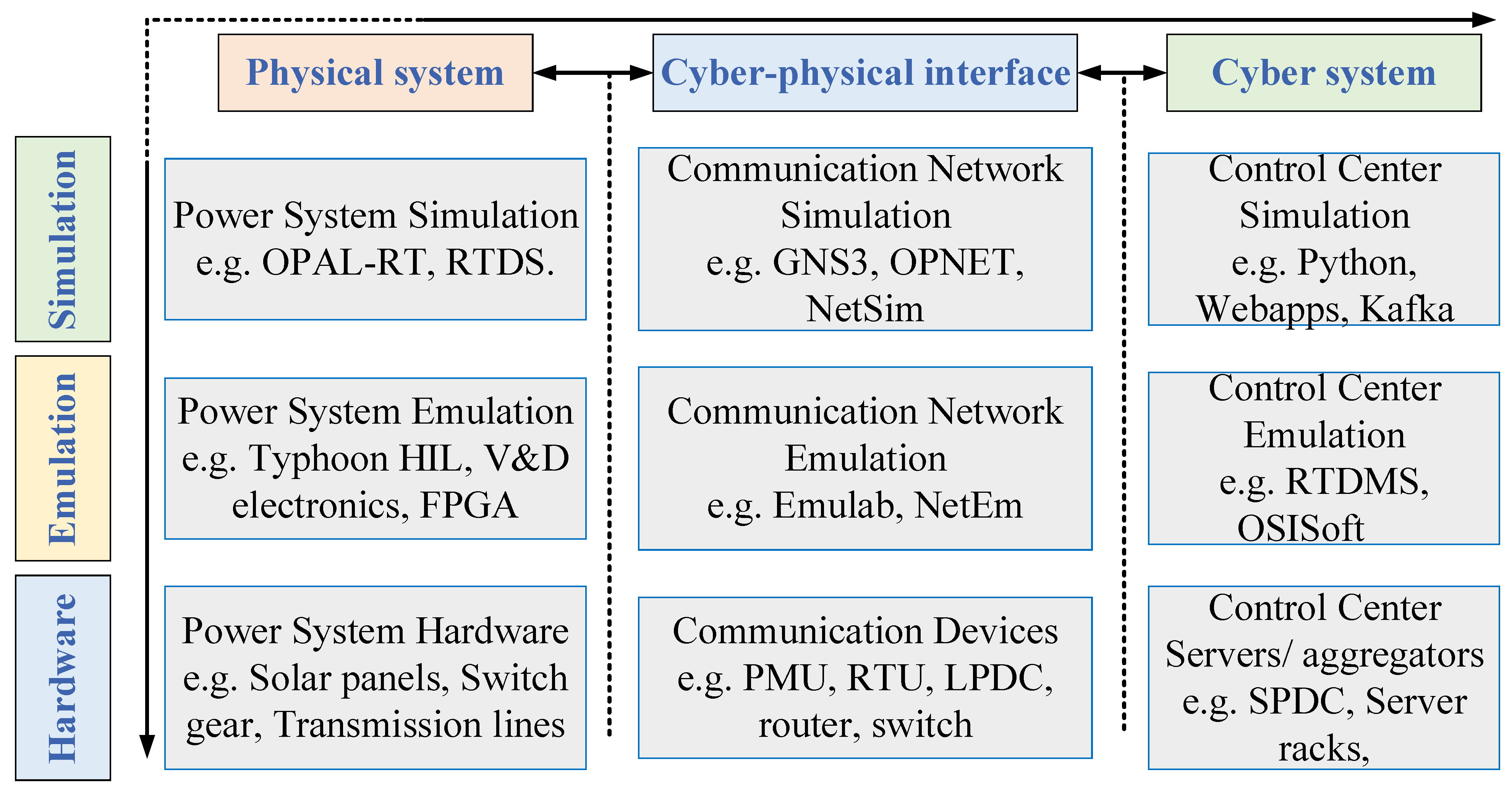
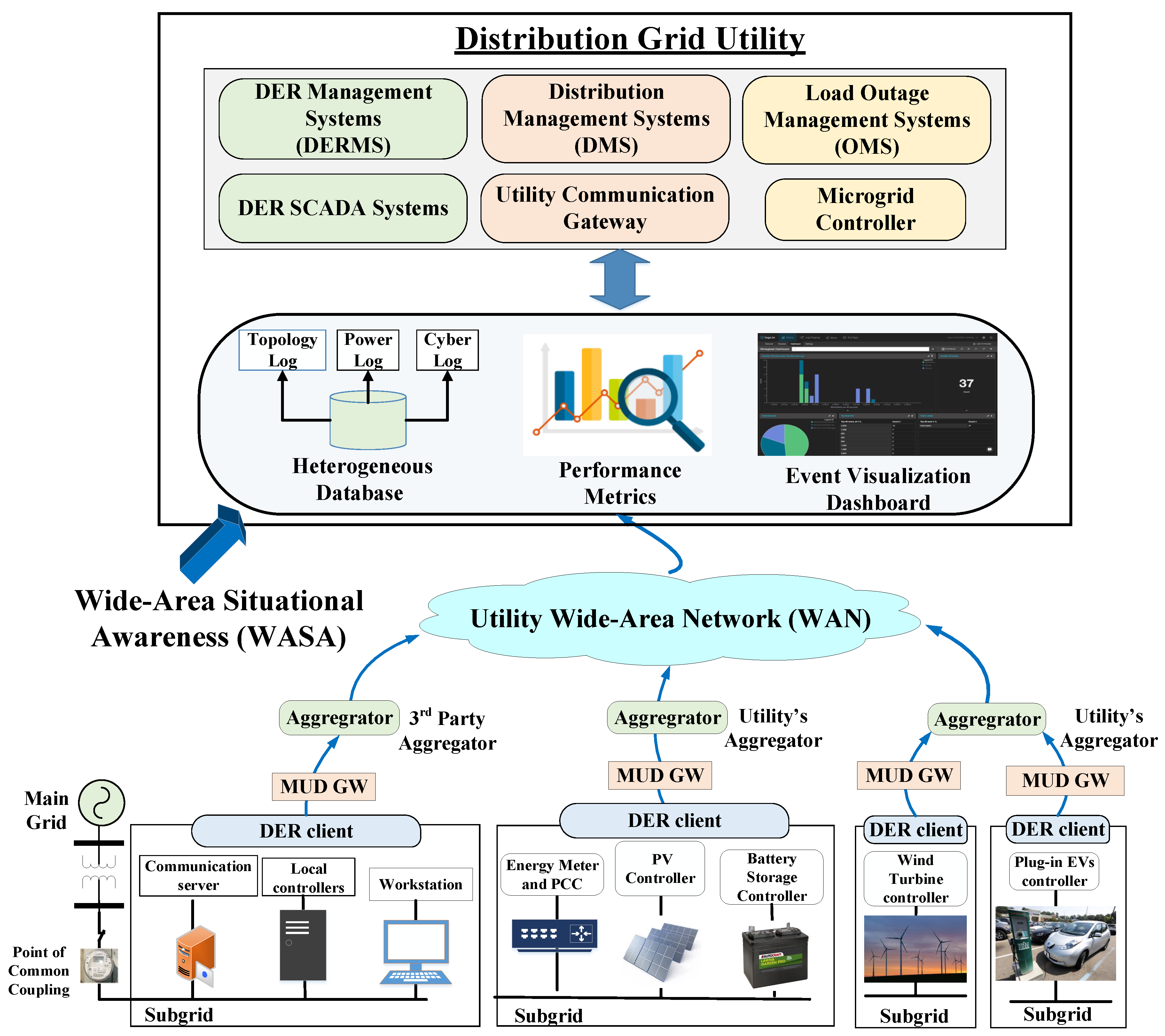

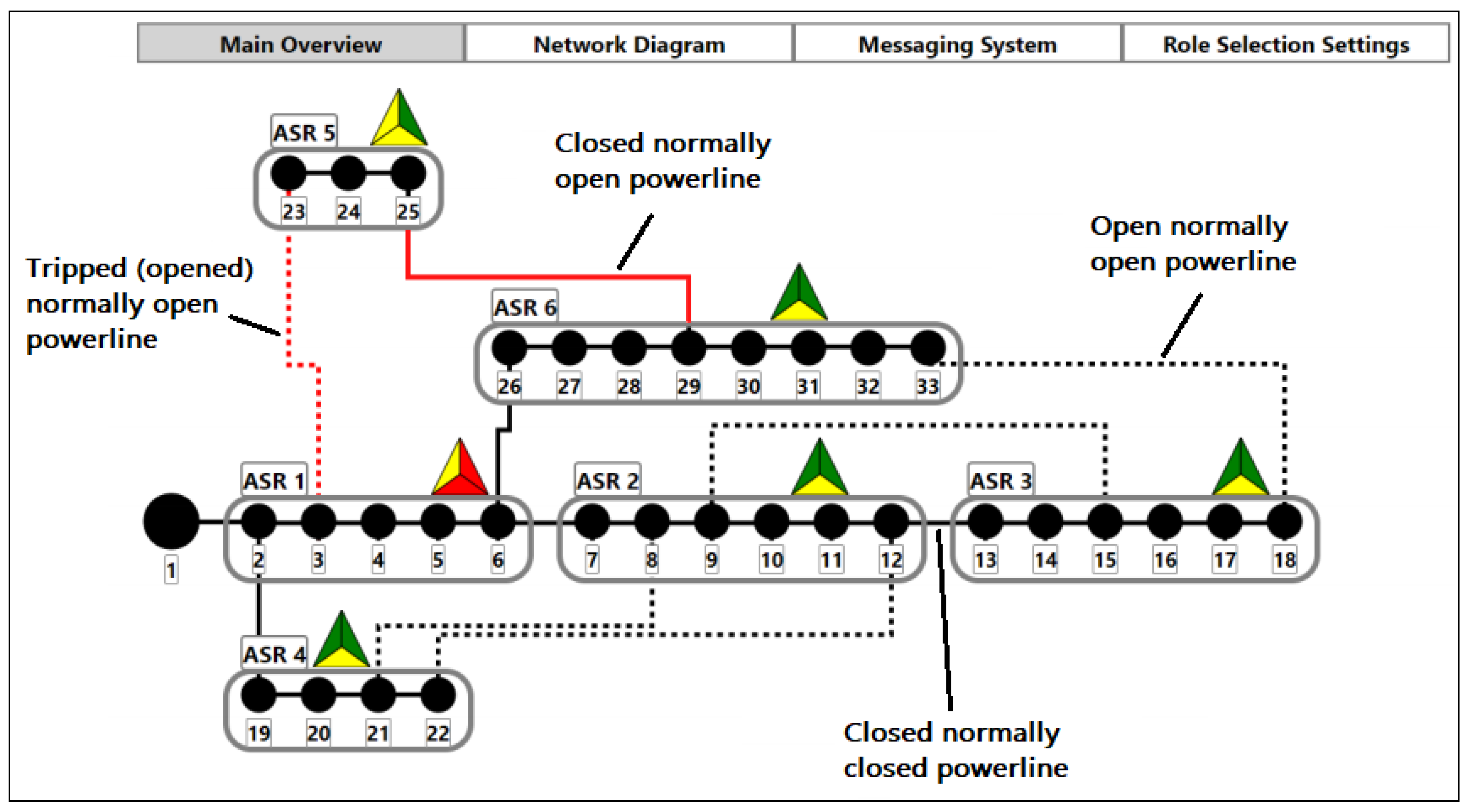
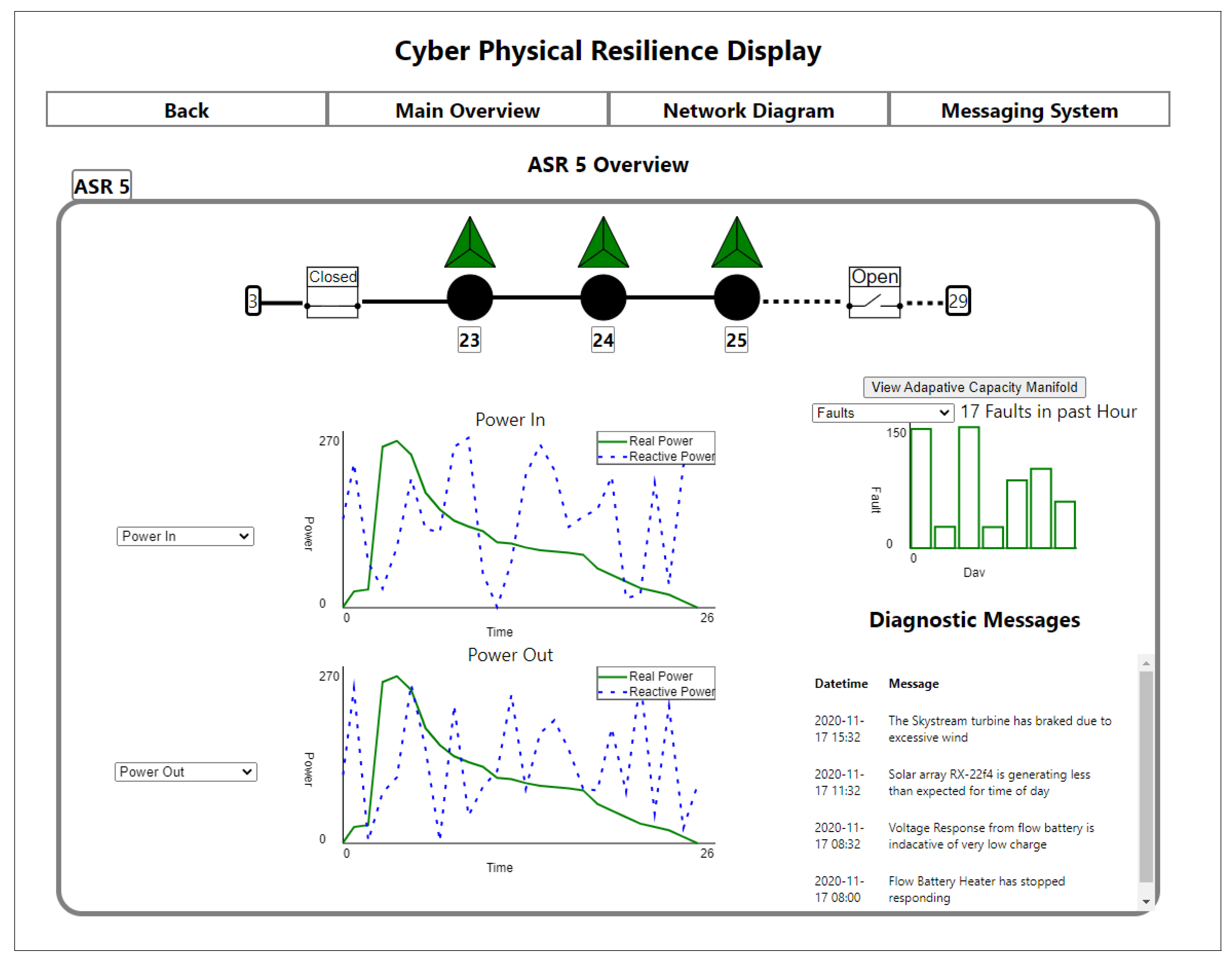
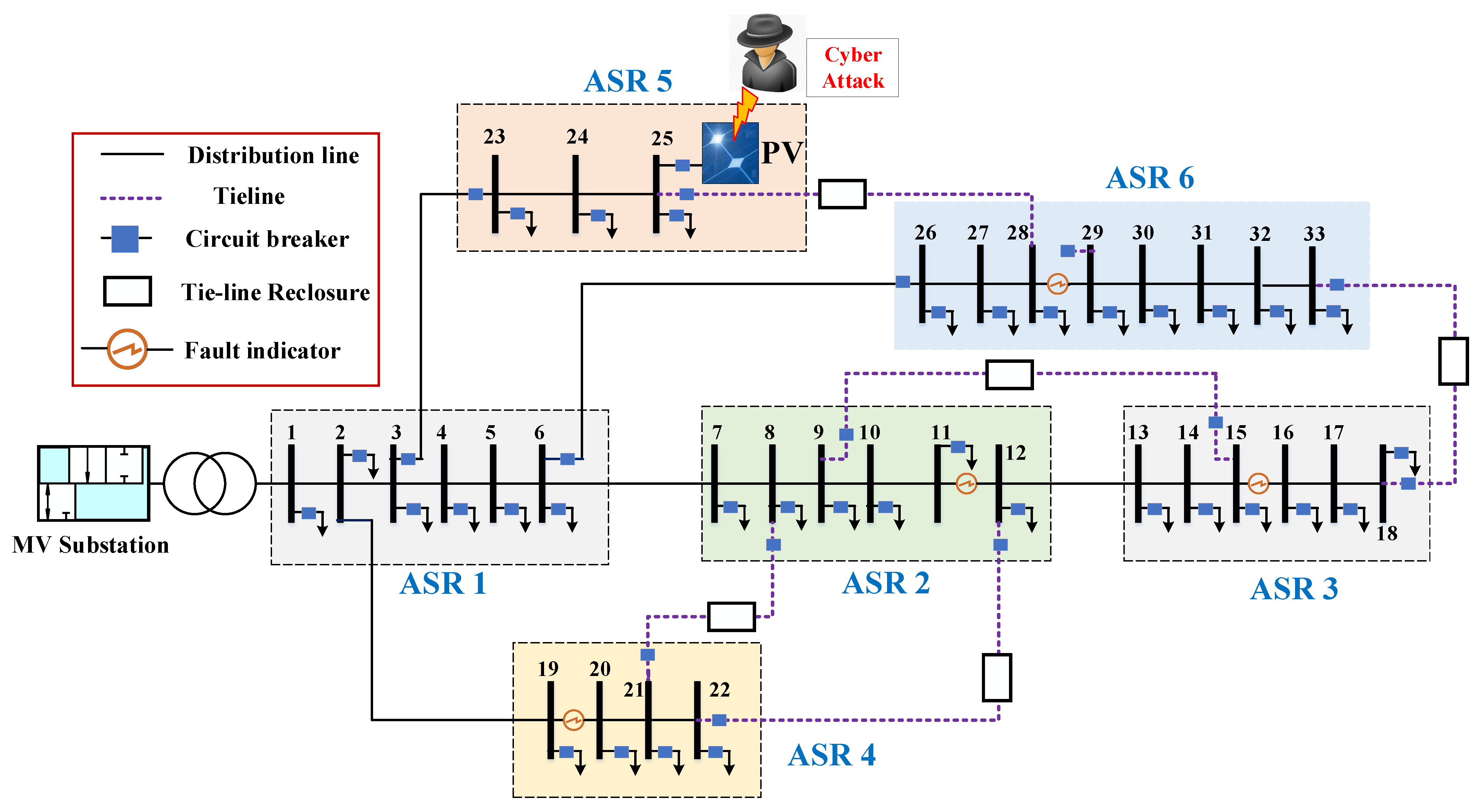
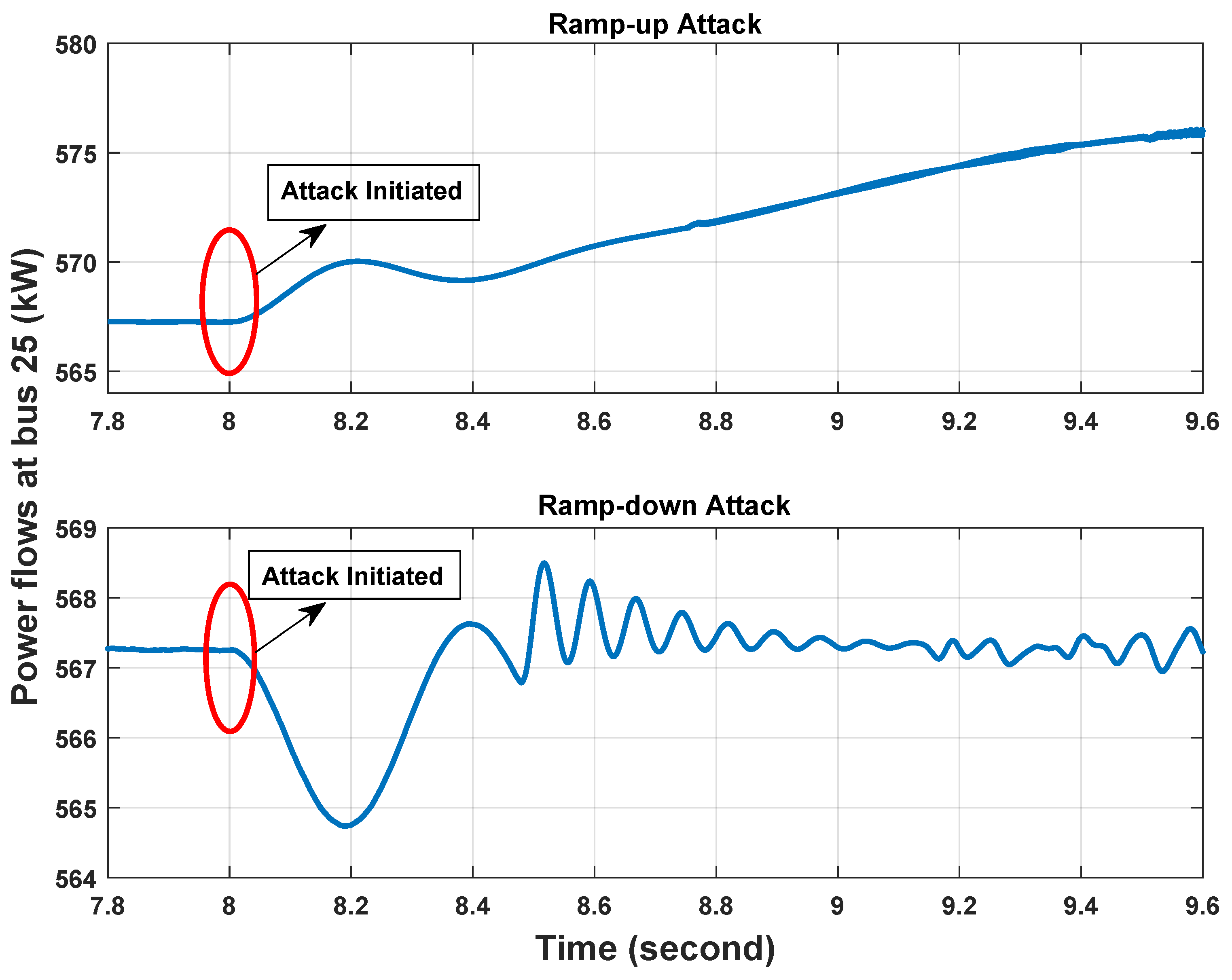
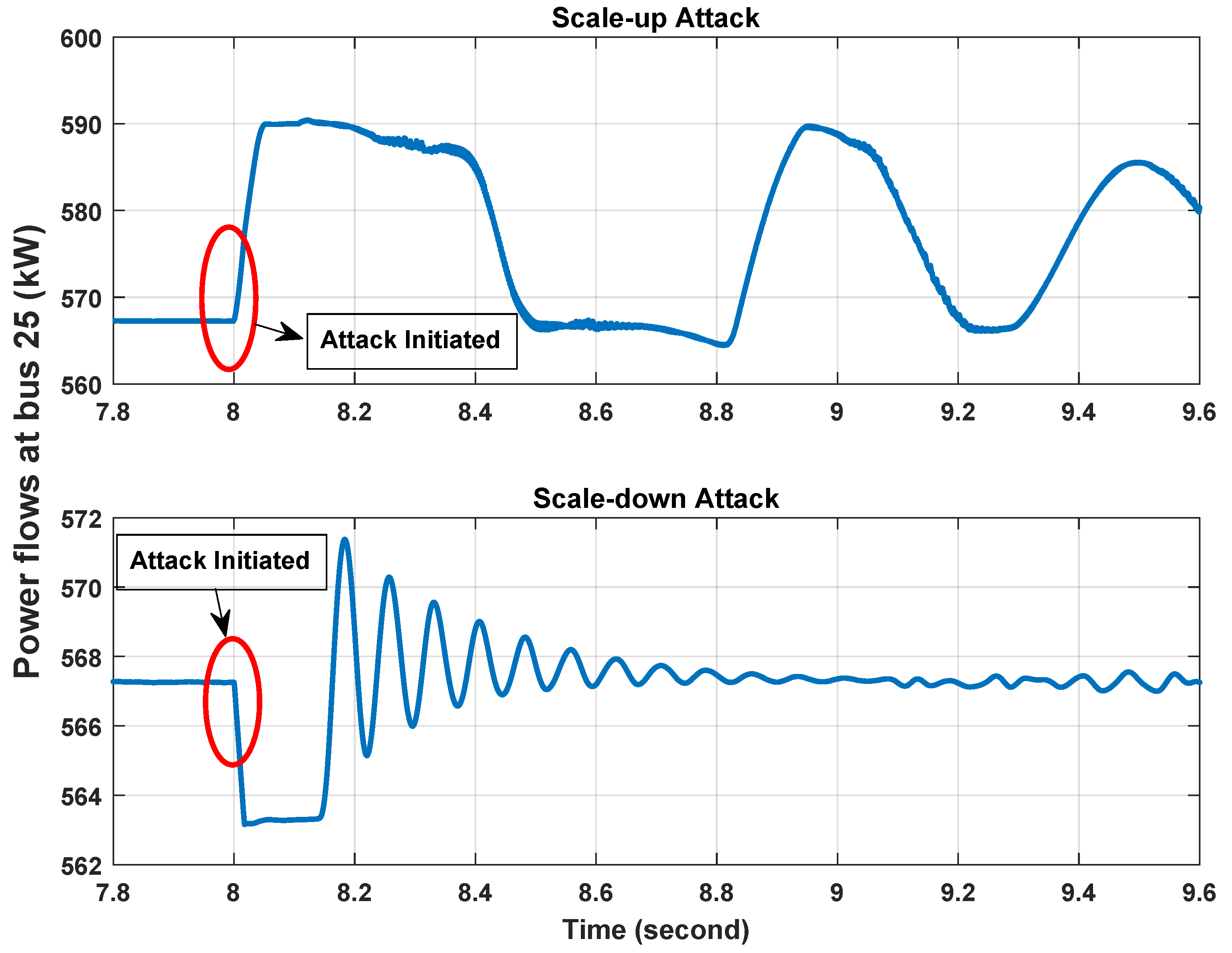
| Simulation | Emulation | Hardware | |
|---|---|---|---|
| Cost | Low | Medium | High |
| Fidelity | Low | Medium | High |
| Scalability | High | Medium-high | Low |
| Interoperability | Low | Medium-high | High |
| Computational expense | Low | High | None |
| Protocols | Locations | Advantages | Vulnerabilities |
|---|---|---|---|
| DNP3 (IEEE 1815) | Control center (master unit) and outstation devices [32] | High reliability and flexibility | Unsolicited message attack, Data set injection, Passive network reconnaissance [32] |
| Modbus | Control center (master unit) and outstation devices [33], substation networks | Open access standard, easy implementation | Malware, spoofing, Man-in-the-Middle, DoS, Replay [33,34] |
| OPC | Control center and outstation devices | Operating system agnostic, open access standard | malware [35], Relay attacks |
| IEC 60870 | Control center, substation networks | Follows the OSI model | Spoofing, sniffing, data modification, relay, non-repudiation [36] |
| IEC 61850 | Substation networks | Highly flexible, focus on adaptable substation automation, substation hierarchy easily viewed | Unauthorized access, DoS, spoofing, Man-in-the-Middle, data interception [37] |
| IEEE C37.118 | WAN, substation networks | Supports real-time data transfer | DoS, reconnaissance, authentication, man-in-the-middle, replay [38] |
| Protocols | Applications | Advantages | Vulnerabilities |
|---|---|---|---|
| GNSS | Synchrophasor [48] | Time synchronization across large geographic areas | Spoofing [52], DoS [53] |
| IRIG (IEEE 1344) | Synchrophasors | Contains a clock, quality indicator | DoS, eavesdropping (if not encrypted) [54] |
| NTP | Substation, microgrid, control center, power electronics outstation devices, SCADA | Universally adopted | Malicious packet delays [55], ARP spoofing [55] |
| IEEE 1588 | Control center, substation networks | High degree of accuracy | Time synchronization attacks [56] |
| Testing Method | Description | Drawback |
|---|---|---|
| Model based | Simulates testbed behavior to validate performance | Depends on model accuracy, may lack practicality on CPTs largely comprised of simulations |
| Search based | Discovers anomalous operating points and scope test bed limitations | Large effort to creating SBT algorithm, time consuming testing |
| Monitor based | Analyzes test bed properties (e.g., voltage) for conformity to expected results | Logical outputs may not always be intuitively known |
| Fault injection | Injects artificial failure to test for expected response | Test bed fault response may not always be intuitively known |
| Big data driven | Leverages big data techniques (e.g., statistics) to test for expected response | Big data collection not always available or practical |
| Cloud based | Leverages cloud computing to test for expected response | Big data collection and cloud connection not always available or practical |
Publisher’s Note: MDPI stays neutral with regard to jurisdictional claims in published maps and institutional affiliations. |
© 2021 by the authors. Licensee MDPI, Basel, Switzerland. This article is an open access article distributed under the terms and conditions of the Creative Commons Attribution (CC BY) license (http://creativecommons.org/licenses/by/4.0/).
Share and Cite
Vaagensmith, B.; Singh, V.K.; Ivans, R.; Marino, D.L.; Wickramasinghe, C.S.; Lehmer, J.; Phillips, T.; Rieger, C.; Manic, M. Review of Design Elements within Power Infrastructure Cyber–Physical Test Beds as Threat Analysis Environments. Energies 2021, 14, 1409. https://doi.org/10.3390/en14051409
Vaagensmith B, Singh VK, Ivans R, Marino DL, Wickramasinghe CS, Lehmer J, Phillips T, Rieger C, Manic M. Review of Design Elements within Power Infrastructure Cyber–Physical Test Beds as Threat Analysis Environments. Energies. 2021; 14(5):1409. https://doi.org/10.3390/en14051409
Chicago/Turabian StyleVaagensmith, Bjorn, Vivek Kumar Singh, Robert Ivans, Daniel L. Marino, Chathurika S. Wickramasinghe, Jacob Lehmer, Tyler Phillips, Craig Rieger, and Milos Manic. 2021. "Review of Design Elements within Power Infrastructure Cyber–Physical Test Beds as Threat Analysis Environments" Energies 14, no. 5: 1409. https://doi.org/10.3390/en14051409
APA StyleVaagensmith, B., Singh, V. K., Ivans, R., Marino, D. L., Wickramasinghe, C. S., Lehmer, J., Phillips, T., Rieger, C., & Manic, M. (2021). Review of Design Elements within Power Infrastructure Cyber–Physical Test Beds as Threat Analysis Environments. Energies, 14(5), 1409. https://doi.org/10.3390/en14051409







